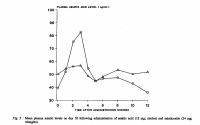Some future additions to the protocol
Telomerase Activation
A recent paper has found some fairly potent telomerase activators, related but not the same as cycloastragenol – namely various triterpenes, the most effective being a 95% purity extract of the triterpenes in Gotu Kola, at peak effectiveness providing about 17% of HELA in immune cells (compared to about 3% for TA-65). This was at a very low concentration (0.02mg/ml). Ten times the concentration was slightly less effective, whilst 100 times the concentration gave almost no telomerase benefit (without causing any outright harm). Given that the strongest triterpene content Gotu Kola supplement I can find has 20% triterpenes, getting the same results in vivo seems plausible. I couldn’t find any bioavailability or half-life information for humans, but on the bright side, various health benefits for Gotu Kola are reported by users on Amazon. The study also confirms the small but apparently robust benefits of Vitamin D for telomerase. [doi: 10.3892/mmr.2019.10614].
Stem Cell mobilisation
AFA (Aphanizomenon Flos-Aquae), Fuciodan and Sea Buckthorn Berry extract all have some evidence for increasing the release of stem cells from the bone marrow [DOI: 10.1016/j.carrev.2007.03.004, 10.1016/j.exphem.2007.02.009, http://dx.doi.org/10.2147/CIA.s186893]. Ordinarily this would be done to increase healing after injury, or for general health, for the former there is some evidence of effectiveness [DOI: 10.19080/NTAB.2017.01.555564, DOI: 10.15406/mojcsr.2015.02.00023]. I think combining this with the Statin-Sartan Protocol, which is hypothesized to partially block differentiation whilst selecting for the expansion of the smallest, more multipotent cells, would be highly synergistic. AFA seems to be the most effective of the proposed substances, and this supplement also has fucoidan (https://www.stemenhance.co.uk/cerule-stemenhance-ultra).
I found two supplements in amazon from reputable brands, one with 30% triterpenes in phytosome(60mg per pill) around 13$ for 60 pills(Swanson phytosome gotu kola), and one without phytosomes but 35% triterpenes(257mg per pill) 30$ 30 pills(Life extension arterial protect)
Also
During prolonged treatment, especially with higher doses, the metabolism of active constituents slows down and can produce toxicity, so it was suggested that this pharmacokinetic phenomena should be considered during pharmacotherapy for effective and safe treatment[78]. The use of CA for more than 6 weeks is not recommended in the literature. People taking the herb for an extended period of time (up to 6 weeks) should take a 2-week break before taking the herb again. The standardized CA extracts and asiaticoside were well tolerated in experimental animals especially by oral route. Asiaticoside did not show any sign of toxicity up to the dose of 1 mg/kg after oral administration, whereas the toxic dose by intramuscular application reported for mice and rabbits was 40-50 mg/kg[79].
Pharmacological Review on Centella asiatica: A Potential Herbal Cure-all (nih.gov)
It appears that gotu kola needs to be cycled and can't be taken continually
Edited by Castiel, 03 January 2021 - 03:48 AM.



























































